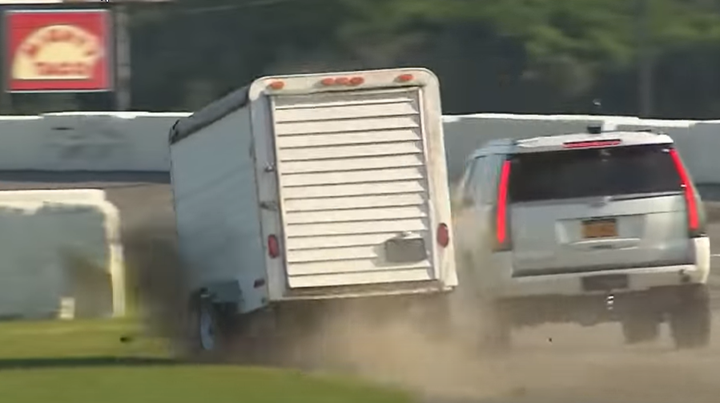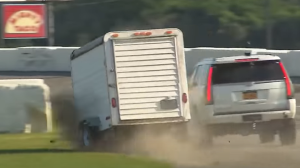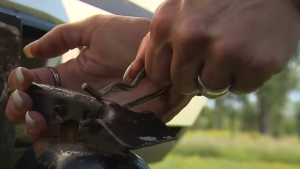
How to Load a Trailer Hitch – Part 2 (Go to Part 1 here): Towing a trailer can open up a world of possibilities, from embarking on adventurous road trips to hauling essential cargo. However, improperly loading a trailer hitch can transform this exciting venture into a dangerous one. According to the National Highway Traffic Safety Administration (NHTSA), trailer sway contributes to numerous accidents each year. Ensuring your trailer hitch is loaded correctly isn’t just about convenience—it’s a crucial safety measure that can prevent deadly mishaps on the road.
In this comprehensive guide, we’ll explore the critical techniques and best practices for loading a trailer hitch correctly to avoid trailer sway. We’ll discuss the fundamentals of weight distribution, choosing the right hitch, securing your load, and essential driving tips to keep you and others safe. Whether you’re a seasoned tower or a beginner, these invaluable insights will enhance your towing experience and give you the confidence to haul anything with peace of mind.
4. Ensuring Proper Tongue Weight
Maintaining the right tongue weight is crucial for towing stability and safety. Here’s how to ensure proper tongue weight:
Measuring Tongue Weight:
Use a tongue weight scale to measure the downward force exerted by the trailer onto the hitch. Here are the steps:
- Position the Scale: Place the tongue weight scale on a hard, flat surface.
- Hitch the Trailer: Lower the trailer hitch onto the scale until it supports the full weight of the trailer tongue.
- Read the Measurement: Record the tongue weight displayed on the scale.
Adjusting Tongue Weight:
Too Light: If the tongue weight is less than 10% of the GTW, move more weight forward in the trailer. Shifting heavier items towards the front can increase the tongue weight and improve stability.
Too Heavy: If the tongue weight exceeds 15% of the GTW, redistribute the load towards the rear of the trailer. Removing some weight from the front and placing it behind the axle can reduce the tongue weight.
Balancing Methods:
Load Distribution: Use weight-distributing hitches that help balance the load across the vehicle and trailer axles.
Modifications: If necessary, consider structural modifications to the trailer to redistribute weight effectively.
Maintaining the proper tongue weight ensures optimal towing performance and significantly reduces the risk of trailer sway, enhancing overall road safety.
5. Pre-Trip Checks and Adjustments
Before embarking on your journey, it’s crucial to perform thorough pre-trip checks and make any necessary adjustments to ensure a safe towing experience:
Trailer Hitch Inspection Checklist:
- Hitch Connection: Verify that the trailer is securely hitched to the tow vehicle. Ensure the hitch ball and coupler are properly connected and locked.
- Safety Chains: Attach the safety chains in a crisscross pattern underneath the hitch connection. This helps catch the trailer tongue if it detaches.
- Electrical Connections: Check that all electrical connections are secure and functioning. Test the trailer’s lights (brake lights, turn signals, and running lights).
- Tires: Inspect the tires on both the tow vehicle and the trailer. Ensure they are inflated to the recommended pressure and check for any signs of wear or damage.
- Brakes: Test the trailer’s brakes, if equipped, to ensure they are operating correctly.
- Mirrors: Adjust your side mirrors for optimal visibility of the trailer and surrounding traffic.
Test Drive:
Perform a short test drive around your neighborhood or in a parking lot to ensure the trailer is balanced, the load is secure, and all connections are functioning correctly. Pay attention to how the vehicle handles, and make any necessary adjustments before heading out on the road.
Taking the time to perform these pre-trip checks can prevent potential issues during your journey and ensure a safe towing experience.
6. Driving Tips to Avoid Trailer Sway

Driving with a trailer requires extra caution and specific techniques to avoid trailer sway and ensure safety:
Steering and Braking:
- Smooth Steering: Make smooth, gradual steering inputs to prevent sudden movements that can cause trailer sway. Avoid sharp turns or abrupt changes in direction.
- Controlled Braking: Apply brakes gently and early to give yourself plenty of stopping distance. Sudden or hard braking can cause the trailer to jackknife or sway.
Speed Management:
- Maintain Safe Speeds: Drive at a safe, moderate speed that allows you to react to potential hazards. High speeds increase the likelihood of trailer sway and reduce your ability to control the vehicle.
- Avoid Sudden Speed Changes: Gradually accelerate and decelerate to maintain stability. Rapid speed changes can destabilize the trailer.
Handling Turns:
- Wide Turns: Make wider turns than normal to accommodate the trailer. This prevents the trailer from cutting corners and potentially hitting curbs or obstacles.
- Smooth Cornering: Enter and exit turns smoothly to maintain balance and control.
Other Tips:
- Keep a Safe Following Distance: Maintain a greater distance between your vehicle and the one in front of you to allow for longer stopping distances.
- Be Aware of Wind Conditions: High winds can cause trailer sway. If possible, avoid towing in windy conditions or be prepared to reduce speed and take extra precautions.
By following these driving tips, you can significantly reduce the risk of trailer sway and enjoy a safe towing experience.
7. Common Mistakes and How to Avoid Them – How to Load a Trailer Hitch
Avoiding common mistakes can significantly enhance your towing safety. Here are some frequent errors and how to prevent them:
Overloading:
- Mistake: Exceeding the vehicle’s or trailer’s weight capacity.
- Avoidance: Always check your vehicle and trailer’s maximum towing capacities as specified in the owner’s manual. Ensure the Gross Trailer Weight (GTW) and tongue weight are within these limits.
Improper Securing:
- Mistake: Failing to properly secure the load can lead to items shifting or falling out.
- Avoidance: Use safety pins, high-quality straps, ropes, or chains to firmly secure all items. Double-check that the load is tightly fastened and won’t shift during transit.

Ignoring Weight Distribution:
- Mistake: Loading the trailer without considering weight distribution.
- Avoidance: Balance the load by placing heavy items over or slightly forward of the axle, and distributing weight evenly from side to side. Monitor and maintain proper tongue weight.
Skipping Pre-Trip Checks:
- Mistake: Failing to perform pre-trip checks to ensure everything is secure and functioning.
- Avoidance: Follow a pre-trip checklist to verify hitch connection, safety chains, electrical connections, tire conditions, brakes, and mirrors.
Neglecting Checks During Long Trips:
- Mistake: Assuming the load remains secure throughout the journey without rechecking.
- Avoidance: For longer trips, plan for a stop 15 to 30 minutes into the trip to re-verify and retighten any straps that may have come loose. Regular stops to check the hitch, load security, and tire conditions can prevent issues from arising during your journey.
By recognizing and avoiding these common mistakes, you can contribute to a safer towing experience and prevent accidents.
How To Load a Trailer Hitch – Get Ready For Trailer Hitch Excellence

Towing a trailer safely requires careful preparation and attention to detail. Properly loading your trailer, ensuring correct weight distribution, maintaining the appropriate tongue weight, and following essential driving tips are all crucial steps to avoid trailer sway and other towing-related issues.
Remember to perform thorough pre-trip checks and adjustments, avoid common mistakes, and take extra care when driving. These practices not only enhance your safety but also the safety of others on the road.
By adhering to these guidelines, you can enjoy a smooth and secure towing experience, whether for a short trip around Quebec or a long journey across the country.
Our team of specialists at Autotech Performance, a CAA Quebec certified automotive garage, are ready to answer your questions about how to get your vehicle prepared for towing. Simply give us a call or book an appointment online.
Enjoy safe driving!
Your Team at Autotech Performance
How to Load a Trailer Hitch – Go to Part 1 here



